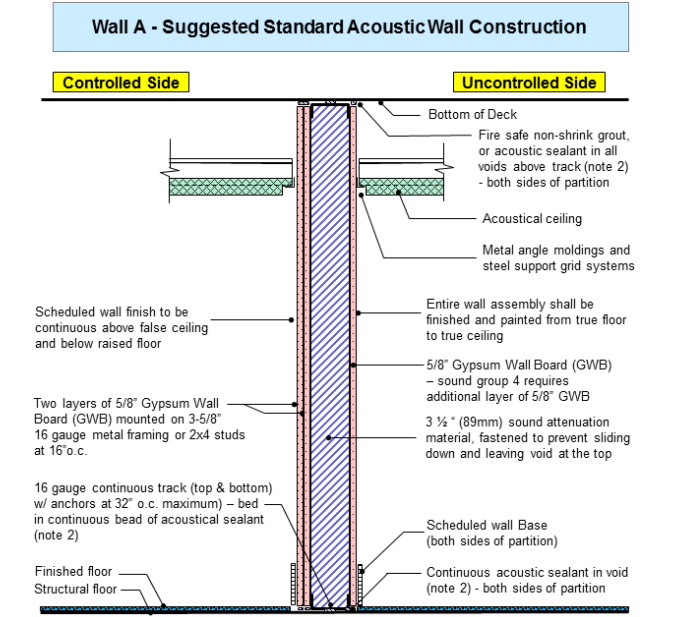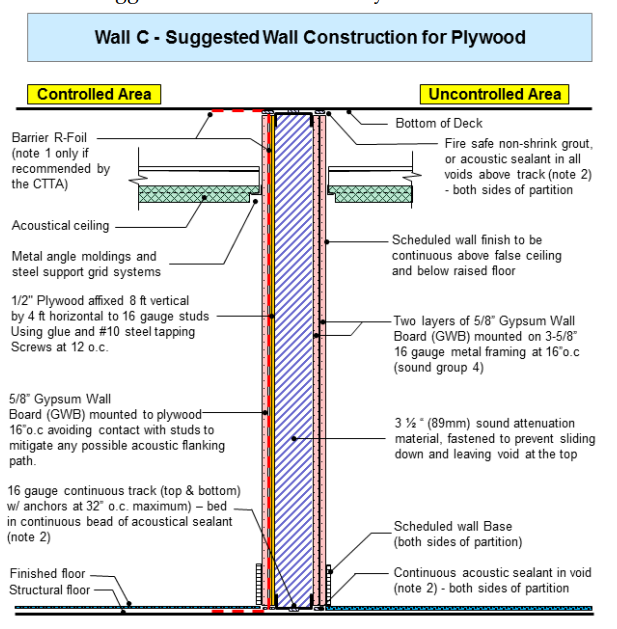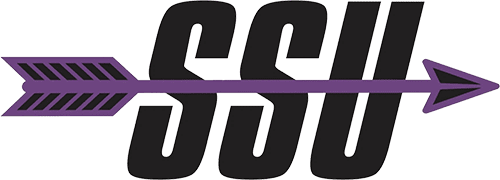
An Overview of ICD 705 Perimeter Wall Requirements
What does the Tech Spec require for perimeter wall construction?
For SCIFs and SAPFs, your first line of physical, acoustic and emanation security is typically your perimeter wall. Because of this, the ICD 705 Technical Specifications, or Tech Spec, lays out extensive requirements to ensure the information processed, held and discussed within the facility is properly safeguarded.
Within the Tech Spec, there are three examples of walls that meet specific requirements you may have for your facility, referred to as Wall Type A, B and C. These designs are not prescriptive, so there is room to have other wall assemblies as long as they meet your acoustic protection and RF shielding requirements and are approved by your Accrediting Official (AO).
General Perimeter Wall Requirements
The Tech Spec lays out the requirements that all walls must meet in Chapter 3 Section C. These requirements include a minimum of three layers of 5/8” gypsum wall board, with two layers on the controlled side and one on the uncontrolled side, staggered seams and acoustic fill. You must use 16 gauge studs placed 16 inches on center, and the wall must be finished and painted from true wall to true ceiling. Generally, it’s standard to paint the wall uniformly the whole way, but some AOs may have their own preference for how the paint should be done. They may want a different color from the rest of the wall in the space above the false ceiling to the true ceiling. Be sure to include painting plans in your design in case the AO has a specific preference so you know what they want from the beginning.
Any penetrations in the wall must be kept to a minimum and the Tech Spec lays out specific instructions for how they must be done in order to maintain the facility’s security.
An existing wall can be used as a perimeter wall for a SCIF without renovation as long as it meets the construction standards and is made from substantial material such as brick or concrete.
Your requirements for RF shielding and acoustic protection will create the requirements for your wall assembly. STC requirements range from 45 STC, where human speech will be unintelligible to those on the uncontrolled side of the wall, to 50 STC, where even loud jazz music wouldn’t be able to be heard outside the perimeter. A higher STC requirement, greater risk of infiltration or TEMPEST mitigations will require further layers and mitigations in the wall.
Enhanced Requirements
If you have an STC 50 requirement, your wall will need to have four layers of drywall instead of three, so there will be two layers on the uncontrolled side and two on the controlled. This should provide the extra acoustic protection needed to meet your requirement.
If your AO determines you have risks and vulnerabilities that require greater physical hardening, you will need to add either a layer of plywood or diamond mesh expanded metal. Plywood is a little more expensive per square foot, but it can replace one of your required layers of drywall and offer acoustic protection, which the expanded metal cannot. It also makes utilities easier to mount, since wall-mounted utilities are a requirement for SCIFs.

TEMPEST is becoming an increasing focus in ICD 705 construction. Should you need to add TEMPEST mitigations to your perimeter, you will be adding RF foil to the drywall. Typically you will be installing this foil yourself. There is drywall that comes with foil backing already attached, but it may not meet your performance requirements. Foil can also be added to plywood.
The ICD 705 Wall Types
Wall Type A: This wall will meet the baseline requirements set out in the Tech Spec without higher standards for physical hardening or acoustic protection. So this means it contains three layers of drywall without plywood or expanded metal with sound attenuation material between the controlled and uncontrolled side.
Wall Type B: This wall type has the three layers of drywall and adds a layer of expanded metal on the controlled side. This would meet an increased physical hardening requirement but does not add further acoustic protection compared to Wall Type A.

Wall Type C: In this assembly, plywood replaces one of the layers of drywall, and both RF foil and an extra layer are added. This assembly would account for TEMPEST concerns and has enhanced acoustic and physical hardening protection.
SCIF walls are the barrier between U.S. adversaries and safeguarded information. Don’t take risks when it comes to their construction. Trust an expert, like the team at Strategic Solutions Unlimited, to build your facility to meet requirements while offering an expedited timeline with our cutting-edge modular technology. Contact us today and we’ll find a solution tailored to your mission’s needs.
Tags: #ICD 705
